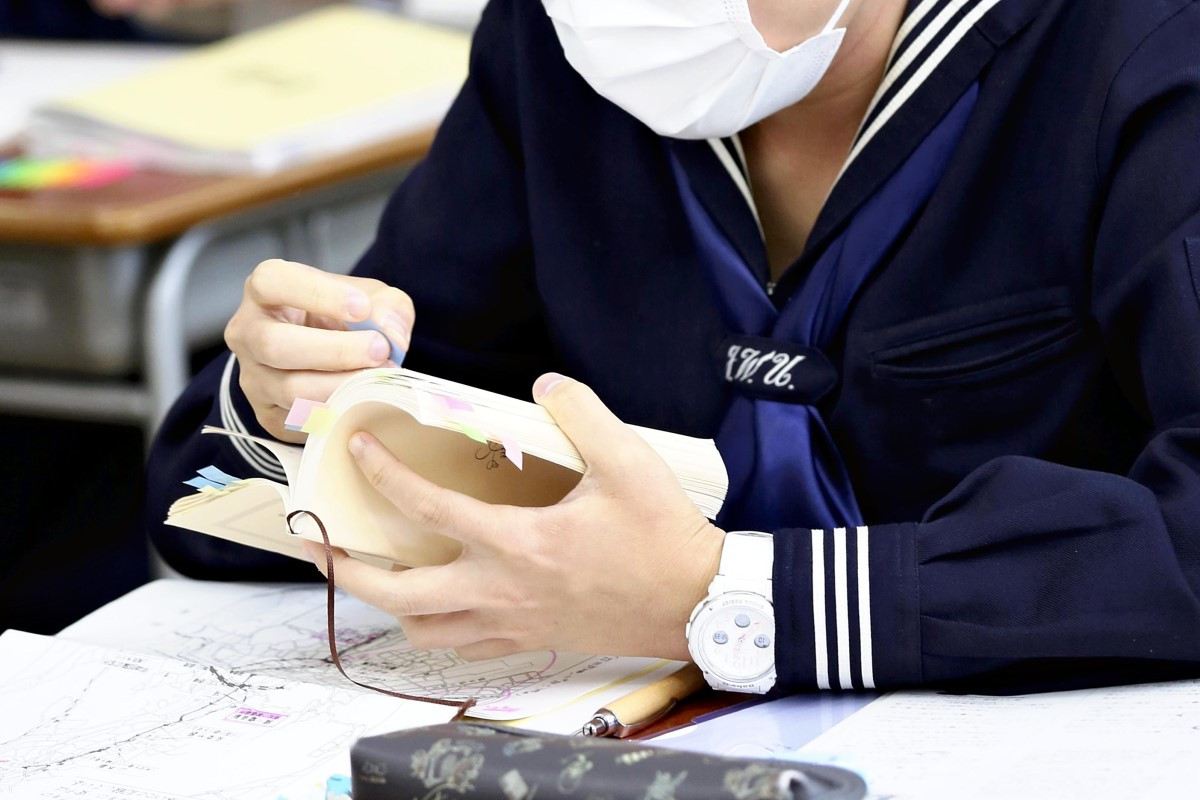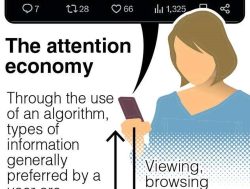
Students read paperbacks in an “intensive reading” class in Kawasaki, Kanagawa Prefecture, in mid-May.
The Yomiuri Shimbun
20:00 JST, June 12, 2023
This is the fifth and final installment in a series probing the threat posed by digitization in schools.
***
Hiromu Abe, a third-year student at a junior high school in Higashi-Matsushima, Miyagi Prefecture, makes it a rule to only use his smartphone until 9 p.m. He spends the rest of the time afterward studying and running outside around his house.
“I feel like I’m using my time in a meaningful way,” he said.
Abe previously spent five hours a day on his smartphone on weekdays and 12 hours on the weekend. He couldn’t take his eyes off video game playthroughs that were posted online one after another.
He was prompted to change this habit by an event last year titled Kodomo Mirai Summit (Summit for children’s future). In the event, elementary and junior high school students in Higashi-Matsushima discussed how to handle smartphones and other digital media.
The participants set a target for how many hours they would spend on smartphones and other digital media per day and named it the Higashi-Matsushima Goal. Students at the junior high school set their own goal of “no more than 90 minutes.”
They also agreed to limit this time to 48 minutes or less at least once a month. The school’s student council employed such measures as calling on students to follow the rules in school announcements.
“I can get into study mode more easily,” said Abe, who has since become one of his school’s top-ranking students.
His classroom teacher said the school initiative has had positive effects.
“The number of students who come to the school infirmary complaining that they feel bad because they aren’t getting enough sleep has declined by 20%,” the teacher said. “Keeping regular hours is the foundation for improving academic skills. We believe a virtuous cycle has been established.”
Intensively read single book
The Junior High School Affiliated With Japan Women’s University has individual students read one paperback in each school term, using half the hours for Japanese language studies for that purpose. The hours are called “intensive reading.”
The school thinks it’s important for students to feel immersed in a book.
Videos on TikTok, a video sharing site popular among junior high and high school students, and many other videos posted on social media are edited to last around 10 seconds. “Literary works in school textbooks are also a kind of excerpt. Online information is even more fragmentary,” said Yukiko Nonaka, principal of the junior high school.
“Careful, close reading of a variety of works will help students look at things from a number of perspectives,” the 60-year-old principal said.
For most of the students, just following a story is the best they can do right after they’ve entered the school. However, this gradually changes as students continue “intensive reading,” according to the principal.
“Students become sensitive to the language and start thinking why certain expressions are used,” Nonaka said. “They become able to read the thoughts and messages that the authors intended to convey.”
Mari Nakahama, 14, said she likes watching short videos on social media and sometimes spends almost two hours watching them. But on the train on her way to and from school, she holds a paperback, not a smartphone.
“Intensive reading doesn’t lead me straight to information, so it may not be time-efficient in that way,” Nakahama said. “But I experience values different from mine through the characters in novels. I can never experience that by watching videos, which I just enjoy for a short time.”
She began to find the time spent on intensive reading important, even though it’s a detour that takes longer.
Adverse effects on kids’ brains
A fiscal 2022 survey conducted by the Cabinet Office on a total of 5,000 students aged 10-17 at elementary, junior high and high schools showed that they spent an average of four hours and 41 minutes online on weekdays.
About 70% of them said they spent longer than three hours online. The average time spent was three hours and 34 minutes among elementary school students, four hours and 37 minutes among junior high school students, and five hours and 45 minutes for high school students. Watching videos was the most common activity.
According to a survey conducted by a research team at the Health, Labor and Welfare Ministry in fiscal 2017, about 930,000 junior high and high school students were suspected to be addicted to the internet, including online games, a significant increase from about 520,000 in the previous survey in fiscal 2012.
Prof. Yasuyuki Taki of Tohoku University, an expert on brain science, urged caution.
“The frontal lobe of the brain, which regulates emotions, is still underdeveloped in children at puberty,” Taki said. “A lot of social media content and online videos stimulate children’s senses. So, it’s important to set up rules for children to follow when using the internet, such as the time to watch, for the sound development of their brains and bodies.”
Parents and guardians play an important role in helping children properly use smartphones and other digital media.
In the town of Miyota in Nagano Prefecture, children at three elementary and junior high schools issued what was called a children’s declaration on internet use three years ago, followed by a declaration by their parents, with parent-teacher associations taking the lead.
Under the initiative, individual families set their own rules on the use of digital media. When children do not follow them, parents are expected to deal with children “strictly” and consider together with their children how to use digital media.
Sachi Tajima, an associate professor at Tokai University who is well versed in children’s use of media, stressed the importance of parents’ role.
“If parents set an example worth following by restricting themselves, it will help raise awareness among children,” she said.
Popular Articles
Popular articles in the past 24 hours
-

Bank of Japan Considered U.S. Tariffs, Coming Shunto Wage Hike Ta...
-

Japan's 1st Domestically Manufactured EV Police Motorcycle Unveil...
-

Kumamoto: Trams to Continue Accepting IC Cards after Strong Oppos...
-

Yen Weakens against Peers after BOJ Raises Interest Rates
-

Colorful New Year Lucky Charm Production Reaches Peak in Shizuoka...
-

Coffee Omakase Is Japan's Love Letter to Caffeine
-

Earthquake with Focus Directly Under Tokyo Could Cause ¥83 Tril. ...
-

Man Found Dead near Trapped Bear in Miyagi Pref.; Victim May Have...
Popular articles in the past week
-

Tsukiji Market Urges Tourists to Avoid Visiting in Year-End
-

Israeli Tourists Refused Accommodation at Hotel in Japan’s Nagano...
-

China to Impose Sanctions on Shigeru Iwasaki, Former Head of Japa...
-

Japan to Support Central Asian Logistics Route That Bypasses Russ...
-

U.S. Senate Resolution Backs Japan, Condemns China's Pressure
-

Speed Skater Yukino Yoshida Clinches Ticket to Milan
-

Kenta Maeda Joins Rakuten Eagles; Returns from American MLB to Ja...
-

Sharp Decline in Number of Chinese Tourists But Overall Number of...
Popular articles in the past month
-

Keidanren Chairman Yoshinobu Tsutsui Visits Kashiwazaki-Kariwa Nu...
-

Imports of Rare Earths from China Facing Delays, May Be Caused by...
-

Japan Exports Rise in October as Slump in U.S. Sales Eases
-

University of Tokyo Professor Discusses Japanese Economic Securit...
-

Japan Pulls out of Vietnam Nuclear Project, Complicating Hanoi's ...
-

Govt Aims to Expand NISA Program Lineup, Abolish Age Restriction
-

Blanket Eel Trade Restrictions Rejected
-

Key Japan Labor Group to Seek Pay Scale Hike
"Society" POPULAR ARTICLE
-

M4.9 Earthquake Hits Tokyo, Neighboring Prefectures
-

M7.5 Earthquake Hits Northern Japan; Tsunami Waves Observed in Hokkaido, Aomori and Iwate Prefectures
-

Tsukiji Market Urges Tourists to Avoid Visiting in Year-End
-

Israeli Tourists Refused Accommodation at Hotel in Japan’s Nagano Pref., Prompting Protest by Israeli Embassy and Probe by Prefecture
-

M5.7 Earthquake Hits Japan’s Kumamoto Pref., Measuring Upper 5 Intensity, No Tsunami Expected
JN ACCESS RANKING
-

Keidanren Chairman Yoshinobu Tsutsui Visits Kashiwazaki-Kariwa Nuclear Power Plant; Inspects New Emergency Safety System
-

Imports of Rare Earths from China Facing Delays, May Be Caused by Deterioration of Japan-China Relations
-

University of Tokyo Professor Discusses Japanese Economic Security in Interview Ahead of Forum
-

Japan Pulls out of Vietnam Nuclear Project, Complicating Hanoi’s Power Plans
-

Govt Aims to Expand NISA Program Lineup, Abolish Age Restriction







